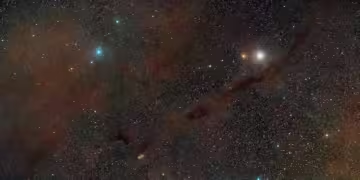Scientists have long speculated that the building blocks of life might have originated in space, carried by ancient clouds of gas and dust before eventually seeding planets. This theory, known as panspermia, has gained new support from recent findings led by a team at MIT. By detecting 1-cyanopyrene, a molecule formed from the polycyclic aromatic hydrocarbon (PAH) pyrene, researchers found evidence that complex carbon structures are not only formed in space but may survive the harsh conditions of interstellar clouds long enough to potentially reach new worlds.
The Role of Complex Carbon Molecules in Life’s Origins
Carbon-based molecules, particularly PAHs, are crucial to life’s fundamental chemistry. PAHs, like pyrene, consist of multiple carbon rings and play a role in forming larger organic molecules that can eventually lead to life. The significance of PAHs lies in their stability and versatility in bonding, providing the backbone for organic chemistry. Pyrene itself is made up of 26 atoms and is one of the largest PAHs detected in interstellar space so far.
The discovery of pyrene-related molecules in the Taurus molecular cloud supports the idea that life’s essential molecules were present in interstellar regions even before Earth formed. PAHs have already been found on meteorites and in distant galaxies, hinting that the fundamental chemistry supporting life might be widespread across the cosmos. This new evidence is another step forward in answering the age-old question: could life be more common in the universe than we thought?
How Scientists Discovered 1-Cyanopyrene in the Taurus Molecular Cloud
The search for 1-cyanopyrene was no easy feat. Unlike simpler molecules, complex PAHs are notoriously difficult to detect due to their low visibility in standard radio telescopic observations. To solve this, scientists at MIT used the Green Bank Telescope in West Virginia, a tool that can detect radio emissions from unique molecules like 1-cyanopyrene. This molecule acts as a “tracer” for pyrene, meaning it emits radio waves that reveal the likely presence of pyrene without requiring its direct detection.
The technique of using tracers allows researchers to estimate the presence and quantity of more elusive molecules by observing their chemical interactions. In this case, 1-cyanopyrene was chosen because it forms from pyrene’s interaction with cyanide, a common compound in interstellar space.
The Resilience of Complex Molecules in Harsh Interstellar Conditions
One of the most striking aspects of this discovery is that pyrene—and by extension, other PAHs—can survive in the intense conditions present in star-forming regions. Previously, scientists believed that complex molecules would break down under the high-energy radiation typical of such environments. Yet, evidence from this study shows that pyrene can remain stable, even as clouds collapse to form stars and planets. This resilience was also observed in samples from the asteroid Ryugu, where large quantities of pyrene were detected, supporting the theory that such molecules have traveled through space and potentially reached Earth billions of years ago.
The ability of pyrene to withstand radiation means it could have been present during the formation of our Solar System. This challenges the traditional view that only simple molecules can survive in space and suggests that PAHs could be more common than we realize in the early environments of many planetary systems.
Implications for Earth’s Origins and Beyond
The discovery of complex carbon molecules in interstellar clouds has far-reaching implications for our understanding of life’s origins. For Earth, it supports the idea that vital organic compounds were “delivered” to the planet from space, potentially speeding up the development of prebiotic chemistry on early Earth. This notion aligns with the discovery of chiral molecules, which are necessary for life’s complex chemistry, in space. Together, these findings suggest that life’s raw materials could be widely distributed across the galaxy, waiting to take root in suitable environments.
The detection of 1-cyanopyrene also opens doors for the study of exoplanetary atmospheres and surfaces. If PAHs are common in interstellar clouds, they may also be found in the atmospheres of planets orbiting distant stars, particularly those in habitable zones. This widens the scope of astrobiology, as planets with a high concentration of organic molecules could be prime candidates in the search for life.
Conclusion: Toward a Greater Understanding of Life’s Cosmic Origins
In sum, the discovery of complex molecules like 1-cyanopyrene in interstellar clouds is a major step forward in understanding life’s beginnings. These molecules’ resilience and abundance suggest that the seeds of life could exist in many places across the universe, potentially fostering life on planets far beyond our own Solar System. As technology advances, scientists hope to detect more complex compounds and analyze their distributions across various star systems.
Reference:
Soma, T., Sakai, N., Watanabe, Y., & Yamamoto, S. . Complex organic molecules in Taurus Molecular Cloud-1.



















